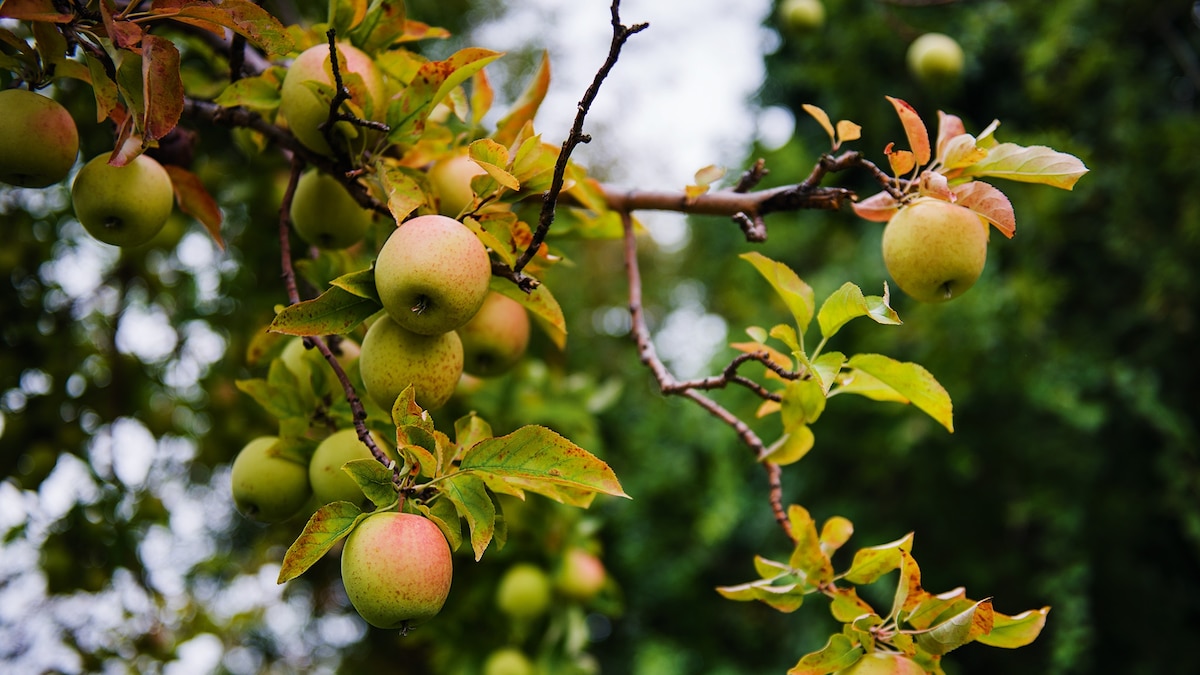Now Reading: Where to try craft spirits and apple cider donuts in New York’s Hudson Valley
-
01
Where to try craft spirits and apple cider donuts in New York’s Hudson Valley
Where to try craft spirits and apple cider donuts in New York’s Hudson Valley

This article was produced by National Geographic Traveller (UK).
The farm distillery: Brown Barn Farms
I pull up at Orange County Distillery’s 100-year-old barn, around an hour’s drive from New York City, as chef Anthony Mario Acevedo is busy preparing pork belly on an outdoor grill. It’s a tempting scent, but before we eat, the distillery’s co-owner John Glebocki is keen to show me the surrounding estate at Brown Barn Farms. Within two minutes, aboard a farm buggy, we’re out into a freshly ploughed field with soil that’s almost charcoal-black.
This 26,000-acre swathe of land, known as the Black Dirt Region, is a protected area containing some of the world’s most fertile soil. It covers much of the southern part of New York state’s Orange County, from the Hudson River at its eastern edge into parts of neighbouring New Jersey. I pick up a handful of the soil from a patch John has just turned over with a spade; it feels soft and silky as it runs through my fingers.
“If I jump up, you’ll feel it, because we’re standing on top of an aquifer,” says John, demonstrating with a stomp on the soil that sends a ripple through the earth beneath our feet. Peat-rich soil soaks up moisture like a sponge from the aquifer (a layer of porous rock or sediment that holds ground water), and this, in combination with its high levels of sulphur and other minerals, enhances the flavours of the produce grown here.
Onions are the Black Dirt Region’s most famous produce; 10% of the US’s onions hail from here. John spent 24 years growing the alliums before recently switching to grain to support his spirits outfit — corn, wheat, rye and barley all go into Orange County Distillery’s bourbon, whiskey, vodka and gin.

Orange County Distillery’s co-owner, John Glebocki, spent 24 years growing alliums before recently switching to grain to support his spirits outfit — corn, wheat, rye and barley all go into the distillery’s bourbon, whiskey, vodka and gin.
Photograph by Michael Marquand
Back at the old barn — repurposed as a bar and events space — he mixes up a tray of manhattans with 100% rye whiskey, each with one large cube of ice and a pop of red from a single cherry. Just inside the barn’s huge open doors, Anthony lays out a series of sharing plates on a sun-saturated table, decorated with pink and yellow carnations and white baby’s-breath flowers. The dishes include smoked duck and cheddar quesadillas topped with creamy guacamole, and crispy, succulent squares of that pork belly, with salty-sour pickled cucumber, micro greens and a slightly sweet maple-soy dressing. There’s also a wobbly burrata that Anthony and his kitchen team have created, topped with pumpkin seeds and a subtle apple cider reduction made with fruit from nearby Soons Orchard. Both meats come from Quaker Creek Store, a local, small-scale producer with its own smokehouse and shop, and are reflective of Anthony’s preference for using local ingredients.
“There are farms growing pretty much anything you need here, due to the demand from multicultural New York,” says Anthony. “And there’s a really firm tenderness to the vegetables grown,” he adds, noting how well the produce cooks to al dente perfection.
As for the onions, that flavour-enhancing soil brings out their sweetness, making them ideal for caramelising. For the main course, onion jam with a balsamic vinegar tang tops a medium-rare New York strip steak laid out on cauliflower puree. With its chunky, thick-cut form, the jam combines umami with a contrasting sticky-sweetness from the caramelisation, upgrading the onion from a mere supporting ingredient to a worthy co-star. orangecountydistillery.com
The chocolatier: Warwick Chocolate Company
Pushing open the door, I find Victor Gelman behind a glass counter filled with truffles in a variety of shapes and forms — plump hearts, orbs, swirls and squares encasing a spectrum of ganaches. Lining one wall of his chocolate shop are bars in enough flavours to give Willy Wonka a run for his money — birthday cake, chilli, golden chai-turmeric, cassis, peanut butter, cherry pecan…
“We have 30 truffles and 50 different bars — that’s years of repressed creativity,” says the founder and chocolatier, alluding to his past life in Brooklyn as a chocolate wholesaler to big brands such as Whole Foods Market, Williams Sonoma, The Fresh Market and Eataly. “One of the reasons I switched to a little shop in a quaint town is the freedom.”
Victor’s shop is one of numerous independent businesses that line Warwick’s Railroad Avenue, a buzzing row of locally owned companies and restaurants that spill out onto a small piazza. Set in the lower Hudson Valley near the New Jersey border, the town — along with its local ingredients — is very much Victor’s muse. I bite into a glossy, heart-shaped truffle made with cabernet franc from the Warwick Valley area to a traditional Belgian chocolate recipe. The wine-infused sweet dark chocolate ganache has a subtle, dry tanginess. An aromatic bar is flavoured with truffles plus Peruvian single-origin organic coffee beans from Greenwood Lake Roasters Craft Coffee, two villages away, while earl grey truffles are sweeted with honey from a local apiary. Victor’s Warwick Bears, milk and dark chocolate bears, came about after walks he took during the pandemic in Warwick County Park, Sterling Forest State Park and Harriman State Park, when he’d have near-daily sightings of black bears. And there’s even a crunchy, salty-sweet onion bar, made with onion chips, inspired by the Black Dirt Region.

“We have 30 truffles and 50 different bars — that’s years of repressed creativity,” says the founder and chocolatier of Warwick Chocolate Company, Victor Gelman.
Photograph by Michael Marquand
But the Warwick Apple Pie truffle is perhaps the most emblematic of this region. “Because we’re so apple-centric — so much of the local economy and community here rotates around apples — I wanted to make an apple truffle,” Victor says. Blushing rouge, it resembles a real, glossy apple. A bite reveals a viscous caramel — the result of a day spent reducing apple cider made from Warwick-grown apples — layered over an apple ganache and a sweet-cracker pie crust. The truffle is rich and pleasingly sweet with a little crunch: a creative spin on a treasured Hudson Valley export.
The apple orchard: Dr. Davies Farm
Chris Nevin waves to me from Dr Davies Farm Stand — a stall at the entrance to her family’s farm estate — as a group of school children sets off on a ‘hayride’ around the property. New York state’s official fruit has been the apple since 1976, and visiting an orchard on the weekend is a favourite pastime here. Back in the 1980s, Chris’s father was one of the first farmers in the Hudson Valley to open up his operation to visitors.

New York State’s official fruit has been the apple since 1976, and visiting an orchard on the weekend is a favourite pastime here.
Photograph by Michael Marquand
Now that the tractor-drawn trailer has disappeared into the orchards — and with it the laughter and chatter of the kids — it’s quiet at the farm stall. If it were a weekend, though, the 65-acre farm would be alive with locals and New Yorkers, stocking up on produce and preserves, picking apples (in the autumn) or peaches (in the summer) and lingering over live music and a bite at various food trucks.
Chris gets us a cider from the outdoor bar — non-alcoholic, as is standard in the US, where ‘cider’ usually means unfiltered apple juice. The farm also makes the hard stuff under the Red Barn Cidery brand, which includes a crisp rosé version. As we sip the steaming-hot, sweet beverage, she tells me how her great-grandmother, Dr Lucy Virginia Meriweather Davies, one of the first female physicians in the state, set up the farm in 1891. It remains a family business: siblings and children help, and Chris lives on-site with her husband, Jeff, who gives us a lift to the orchard in a trailer. The first trees we reach are laden with Golden Delicious — a touch of peach colouring their yellow-green skin — and deep-red Rome apples. Jeff uses a picking pole to select a Fiji from the top of another tree.
I bite into a juicy, just-plucked Cortland. The spotted, deep purplish-red apple has soft, peachy-sweet flesh with subtle tartness, while a Pink Lady is crisp and far more piquant than those I’m used to from supermarkets.
“People will say, ‘I’ve never liked Golden Delicious’,” says Chris. “But they taste one from our trees and tell us it’s the best apple they’ve ever had.”
The breakfast: Albergo Allegria
Walk The Windham Path, a 1.5-mile circular route on the edge of the eponymous resort town in the Catskill Mountains, and you could be in a painting. Indeed, the Hudson River School, America’s first major art movement, brought attention, and tourism, to the region in the mid-19th century. A tree-lined stream gives way to a grassy plain surrounded by forested peaks.

Scrambled with artichokes, manchego cheese and sun-dried tomatoes, ‘Nonna’s eggs’ are served on toasted bread made with arborio rice.
Photograph by Michael Marquand
Veer off The Windham Path back onto the main road, and you’ll find Albergo Allegria, a hotel whose restaurant breakfasts and takeaway picnics set up diners up for a day in the mountains. It’s decked out with antique knick-knacks, a 1920s stove and white-lace tablecloths, so it seems fitting that chef and owner Marianna Leman presents us with ‘Nonna’s eggs’ — an homage to her grandmother’s cooking. Scrambled with artichokes, manchego cheese and sun-dried tomatoes, the eggs are served on toasted bread made with arborio rice. “I don’t call myself a chef, I call myself a chef’s daughter,” says Marianna, who moved here from Long Island aged nine, when her Italian-Croatian family began running the hotel.
Marianna’s mother was the first woman to graduate in culinary arts from the New York Institute of Technology. “Everything I do pays homage. My dad would buy something and use the whole thing — he’d gather chicken wings [which weren’t used in the restaurant] and freeze them to cook when he’d enough, to pass around the bar so they wouldn’t go to waste.”
Marianna grows herbs — including borage, for floral garnishes — and vegetables such as courgettes, beetroots and heirloom tomatoes in the hotel kitchen garden’s 13 raised beds, and sources locally wherever possible.
A ‘Catskill mountain duffel’ arrives at the table — an omelette of melted cheese and fiery habaneros, served with cornbread, corn ribs and salsa. Then come buttermilk waffles with a side of whipped cream, topped with apple butter and dried garden apple. It’s clear from all this fresh, hearty fare that every scrap of the season’s harvest has gone into creating plentiful breakfast dishes.
Published in Issue 27 (spring 2025) of Food by National Geographic Traveller (UK).
To subscribe to National Geographic Traveller (UK) magazine click here. (Available in select countries only).

























